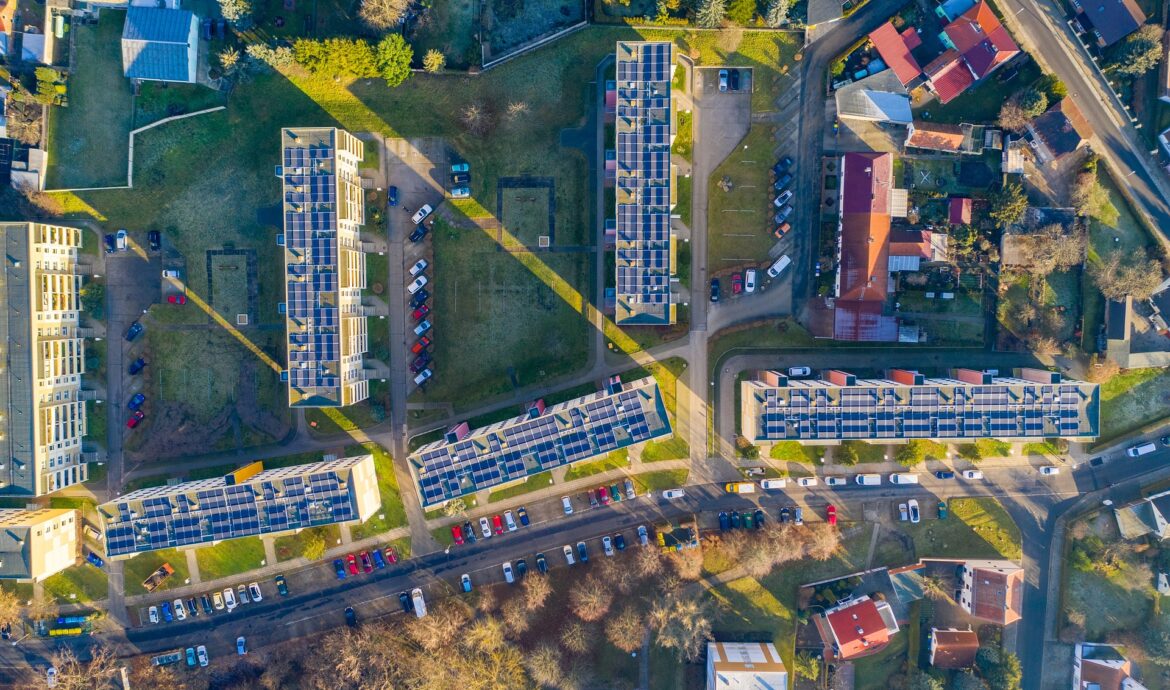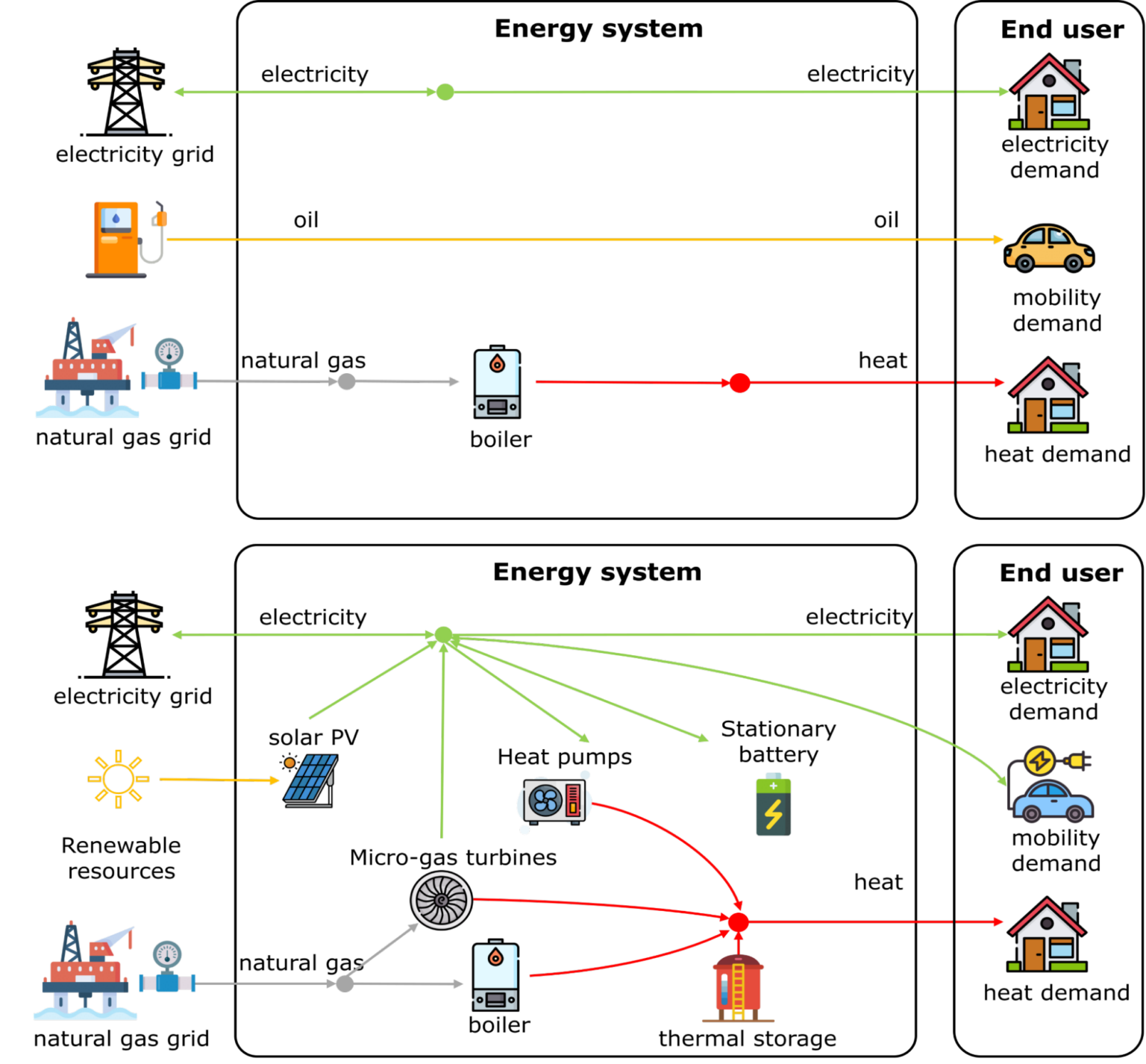
The search for clean flexible power: what can low-carbon multi-energy systems offer?
On 02.08.2023 by Arvind SrinivasanBy Arvind Srinivasan

Arvind is a PhD candidate at the Laboratory of Reliability & Risk Engineering at ETH Zurich. His research investigates optimal sector-coupled energy system designs at the distributed scale with a focus on the security of supply.
The integration of renewable energies increases the need for flexible power to be able to always match supply and demand. One source of clean flexible power could be coming from the end-users as the systems at local scale transition to low-carbon multi-energy systems. The flexibility potential of multi-energy systems for balancing services can be quantified by integrating the rules and rewards governing flexibility in energy system models. It aids the end-users to meet their energy economically and the transmission system operators to drive regulation designs that could maximize flexibility from end-users.
The energy transition is reshaping how end users meet their energy needs.
Increasing deployment of rooftop solar photovoltaics and battery storage solutions are making end-users such as households and firms active participants in meeting renewable targets and fighting climate change. By one estimate, half of Europe’s citizens could be producing up to half of the EU’s renewable energy by 2050. Further, electricity is becoming central to all our energy needs as more of the heating and mobility demand is being met by heat pumps and electric vehicles, respectively. In other words, state-of-art passive systems are reshaping into sector-coupled and active “multi-energy systems” such as shown in Figure 1.
Multi-energy systems provide operational flexibility by providing multiple energy pathways to meet end user demand. Flexibility is the ability of an energy system to always match supply and demand and a service highly valued in future energy systems: the IEA estimates that the need for flexibility is going to quadruple by 2050. Without adequate flexibility, the variability in renewable supply could lead to frequency instability and consequently, potential blackouts.

Figure 1: Energy transition goals are reshaping how end users meet their energy needs- moving away from passive systems (top) towards sector-coupled and active multi-energy systems (bottom). With multiple pathways for energy to flow, multi-energy systems offer high operational flexibility.
Considering flexibility in the future system planning could help end-users reduce their energy bills and maximize the potential of offering flexible supply.
The security of the electricity transmission grid can be enhanced by harnessing the flexibility from future multi-energy communities via offering firm reserves in balancing markets. However, there are trade-offs to offering such flexibility to the transmission grid. Generation capacity offered as firm reserves for flexibility is not available for use for anything else for a set delivery period. Flexibility must be provided immediately on imbalance in the grid and therefore, these reserves need to be always available within the grid network ready to be dispatched whenever needed. The owners of the reserves, like the end-users, are compensated for reserve availability for a set delivery period with prices determined through market auctions. As an alternative to reserving capacities, the system components could have been turned off, thereby saving fuel costs, or the reserve capacity could have been utilized to sell excess electricity using a feed-in scheme. Further, from the system design perspective, components within the system could be sized sufficiently to meet daily energy needs alone, leaving no room for flexibility services. Planning for flexibility simultaneously with other decision characteristics could ensure optimal system utilization while also transitioning to a low carbon system.
Balancing the trade-offs by optimizing for system costs can address whether offering flexibility via balancing services is indeed economical for the end-user.
Our optimization framework attempts to find the optimal balance among the trade-offs and aid end-users to decide upon an ideal local system design. With an objective to minimize costs, the framework decides the optimal size of system technologies, operation strategies, and flexibility potential given the compensation mechanisms available from the balancing market. The advantages of the framework are in supporting better decision making for: (1) end-users to invest in clean technologies that minimize their costs, and (2) transmission system operators to estimate the flexibility potential from end-users and the effectiveness of the regulations and compensation mechanisms in place.
As an application, we consider the case of a small Swiss neighborhood aiming to achieve an 80% reduction in emissions from the present day on their electricity and heating consumption, by shifting to rooftop photovoltaics, stationary battery systems and heat pumps. Historical prices of two balancing services are considered as compensation – primary control reserves (PCR) and secondary control reserves (SCR) with delivery periods of 4 hours and 1 week, respectively, which are representative of the ancillary services market framework in Switzerland.
We consider three scenarios for designing future multi-energy systems and estimating their flexibility potential:
- Case 1: No option of providing flexibility
- Case 2: Flexibility at current delivery periods of 4 hours for PCR and 1 week for SCR services
- Case 3: Flexibility at finer delivery periods than case 2, with 1 hour for both PCR and SCR services.

Figure 2: The left plot shows the investment and operational costs for Case 1, 2 and 3. The costs are for meeting the combined heating and electricity needs. While the investment decisions are unaffected, the operations are more optimized to achieve lower costs. The right plot shows the system designs for the same cases. The system design is unaffected. However, with smaller delivery periods in Case 3, the median flexible capacity on offer from the system increases, as both batteries and heat pumps offer flexible reserves.
The case study results affirm that inclusion of flexibility services alters system costs and operations (Figure 2). From Case 1 to Case 3, flexible capacity reserves in batteries and heat pumps increase. They lower system operation costs and increase transmission system reliability with additional flexible capacity. Although mobility demand is not considered in this case study, a fleet of EVs can potentially add on to the flexible capacity on offer from multi-energy systems as mobility systems continue to electrify.
Interpreting from the end-users perspective, the compensation mechanisms for flexibility are not enough to incentivize design alterations. The energy system may be designed considering the sustainability objectives of the end-users alone (such as the 80% emission reduction in the case study). Our findings suggest that end-users could lower their energy bills by offering flexibility to the electricity grid. The extent of revenues gained depends on the available compensation schemes and regulations set by the transmission system operators. Of course, the possibility for end-users to access these benefits depends on whether regulations allow them to provide balancing services to the grid, as single entities or as part of a balancing group.
Interpreting from the transmission system operator’s perspective, system reliability could be improved as flexible capacity is offered from energy resources at the end-user level. for either case tested. With changes in regulatory and compensatory mechanisms, flexibility from end-users could be better harnessed. Comparing the flexibility in offer from the three cases, it is seen that a regulatory shift to finer delivery periods alone (Case 3), could increase flexibility on offer from the end-users without any changes in compensation schemes.
In the coming decades, with citizen-driven actions to meet renewable and electrification targets, the aggregated flexibility potential from multi-energy systems is likely to scale up significantly. Tapping into this clean flexibility source will become ever more crucial given the shift away from fossil sources such as gas fired power units.
The next research steps would require interdisciplinary collaboration. On the technical side, it would be necessary to quantify the true flexibility potential of local technologies without end-user discomfort. Projects such as the “SWEET PATHFNDR, Pathways on district and city scale” are ongoing on this front which aim to determine an optimal pathway at the local level that also enables holistic utilization of the flexibility using multiple energy carriers. Designing effective regulatory and compensation mechanisms would also support end-user investments and decisions towards a low carbon and flexible energy system. Estimating flexibility needs based on renewable projections and retirement of existing gas-fired flexible sources would also facilitate the use of energy system models, such as the one discussed in this blog, to quantify the available system flexibility under different mechanisms and support in decision making in terms of capacity investments at a broader scale.
Cover image : Image by Solarimo from Pixabay
Keep up with the Energy Blog @ ETH Zurich on Twitter @eth_energy_blog.
Suggested citation: Arvind, Srinivasan. “The search for clean flexible power: what can low-carbon multi-energy systems offer?”, Energy Blog @ ETH Zurich, ETH Zurich, August 02, 2023, https://blogt.ethz.ch/energy/multi-energy-systems

I am missing the power-to-gas technology in Figure 1! Together with biogas (which I consider rather a niche product), it could transform the natural-gas grid into a “green-gas” grid. In my view, this must and will play an important role in a sustainable energy supply.
Thank you for sharing insights into the operational challenges of multi-energy systems. Could you provide more details about the small Swiss neighbourhood with a 100kWp PV and only a 4 kWel. heat pump installation? The ratio of rooftop area to space heating seems unusual. Also, when you mention 33kW, do you mean 33kWh storage capacity (Fig. 2)? How does the 33kWh battery capacity in relation to the 13kWh thermal storage capacity compare with typical ratios in Swiss neighbourhoods? I appreciate your insights.
Thanks for your comments. The system design of the neighbourhood is the outcome of the system optimization from the case study. The demand data considered for the case study had 60 kW and 25 kW of electricity and heating demand respectively. The demand profiles were hourly resolved for a full year time horizon to cover all hourly, daily and seasonal variations. The system is designed to achieve 80% reduction over a system with grid imports and gas boilers. High electricity peak and decarbonisation target led to high PV installations. 33 kW is the battery’s discharge capacity. With a c-rate of 0.25, the battery storage capacity is 132 kWh. Similarly, with a c-rate of 0.33, 13 kW of thermal storage equates to 39 kWh of storage capacity. I unfortunately would not be able to comment on the typical storage ratios in Swiss neighbourhoods. I would happy to discuss personally if you are interested. Thank you.